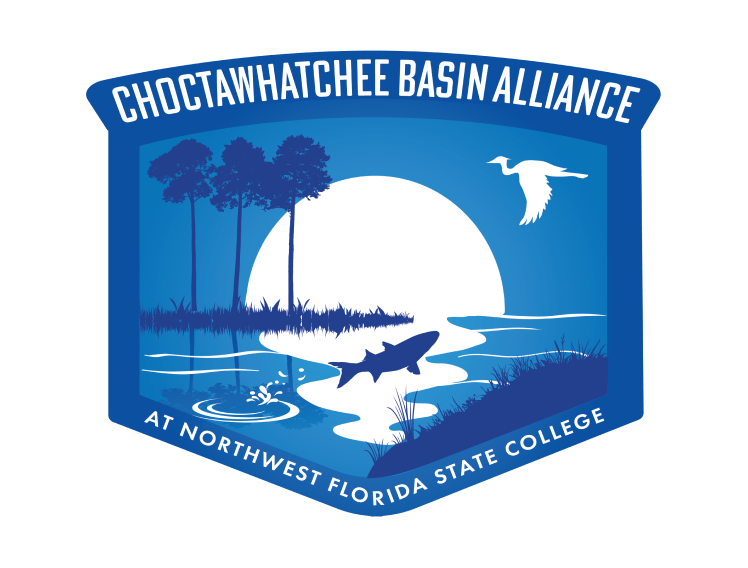
A living shoreline is a shoreline management option that uses living plants, recycled oyster shells, fossilized oyster shell, sand fill, or a combination of natural structures with riprap or offshore breakwaters to protect property from erosion. Living shorelines present an ecological and economic alternative that is viable for low-erosional settings in Choctawhatchee Bay.
In Choctawhatchee Bay, many property owners use hardened structures such as sea walls, riprap, groins and bulkheads (as opposed to Living Shorelines) to stabilize and protect waterfront property from erosion caused by wind and wave action. While these “hard” solutions may prevent some localized shoreline erosion, they often act to increase erosion by reflecting wave energy and altering natural sediment movement. Vertical shoreline structures eliminate the varying water depths, wave attenuation and diverse habitat types associated with natural, gradually sloping beaches, seagrass meadows and salt marshes. Loss of nursery, feeding and refuge habitats leads to loss of vital estuarine species.
CBA’s living shoreline initiative is mainly comprised of two components: oyster shell breakwaters (artificial reefs) and native shoreline grass plantings. Combined, the reefs and shoreline grasses help to reduce shoreline erosion, act as habitat for marine-life, filter stormwater run-off, and improve water clarity and water quality in Choctawhatchee Bay. CBA uses recycled oyster shell to construct artificial reefs that act as a breakwater for impeding erosion.
The oyster reefs not only benefit the stability of the shoreline they are protecting, but they also serve as habitat for intertidal marine life. Many creatures from Choctawhatchee Bay call our reefs their home, including live oysters! Oyster larvae float along in the current and attach themselves to like-surfaces, slowly populating the artificial reef. Oysters are filter-feeders: one adult oyster is capable of filtering 50 gallons of water in one single day. As hundreds of oysters grow on the reef, they improve the water clarity and water quality, benefitting the entire Bay. To stabilize the shoreline, CBA plants smooth cordgrass (Spartina alterniflora). Native shoreline grass such as smooth cordgrass acts as a filter for stormwater run-off, in addition to providing habitat for marine-life and birds.
CBA’s hands-on environmental education program, Grasses In Classes, allows elementary-age youth to fulfill the role of repopulating native shoreline grass by growing, acclimating, monitoring, and planting the smooth cordgrass. In combination with the recycled oyster shell reefs, the native cordgrass restores the degraded shoreline and completes CBA’s living shoreline initiative.

Stormwater is simply water that accumulates on land as a result of storms, and can include runoff from urban areas such as roads and roofs. Historically, stormwater has been diverted away from urban areas and road ways as fast as possible – usually into the nearest waterbody. Our local Choctawhatchee Bay and its bayous receive significant amounts of stormwater from the uplands adjacent to them.
Under the Federal Clean Water Act, local municipalities must obtain a permit to discharge stormwater into local waterbodies. CBA has partnered with local municipalities to help achieve maximum compliance with their National Pollutant Discharge Elimination System (NPDES) Program. The partnership is the initial step in uniting local governmental entities to protect the ecological integrity of the Choctawhatchee Watershed.
The NPDES Program is a mandate from the Environmental Protection Agency that requires municipalities to submit a permit to the Florida Department of Environmental Protection (DEP) that outlines an initial five (5) year strategy on improving water quality through six (6) guidelines:
- Public Education/Outreach
- Public Participation/Involvement
- Illicit Discharge Detection/Elimination
- Construction Site Runoff Control
- Post-Construction Runoff Control
- Pollution Prevention/Good Housekeeping
Currently, CBA works with the City of Destin and Walton County. The products of these partnerships include brochure and newsletter outreach, Sediment and Erosion Control Inspector Training, Illicit Discharge Detection and Elimination Training, rain barrel and rain garden workshops, stormwater education for schoolchildren, and stormwater remediation construction projects.
We have the unique ability to unify the community’s resources in helping our partners achieve maximum compliance with their NPDES permits. These partnerships are a major step to enhancing the overall water quality within the Choctawhatchee Watershed. Through these partnerships, CBA hopes to fulfill all aspects of its mission: to protect and preserve the watershed but also to sustain and provide optimum utilization of the Choctawhatchee Basin Watershed.
For more information about NPDES go to the following link: http://cfpub.epa.gov/npdes/

Using grant funding, CBA removes invasive species from sensitive shoreline areas along the Choctawhatchee Bay and coastal dune lakes. Once removal is complete, staff and volunteers plant native vegetation species to increase the health and resiliency of the waterfront habitat. MORE?


